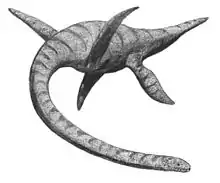1821 in paleontology
Paleontology or palaeontology is the study of prehistoric life forms on Earth through the examination of plant and animal fossils.[1] This includes the study of body fossils, tracks (ichnites), burrows, cast-off parts, fossilised feces (coprolites), palynomorphs and chemical residues. Because humans have encountered fossils for millennia, paleontology has a long history both before and after becoming formalized as a science. This article records significant discoveries and events related to paleontology that occurred or were published in the year 1821.
| |||
|---|---|---|---|
|
Dinosaurs
- On 21 June, Gideon Algernon Mantell displays his Iguanodon fossils to the Geological Society, but arouses little interest.[2]
Plesiosaurs
New taxa
| Taxon | Novelty | Status | Author(s) | Age | Unit | Location | Notes | Images |
|---|---|---|---|---|---|---|---|---|
| Plesiosaurus[3] | Gen. nov. | Valid | William Daniel Conybeare[3] | Sinemurian, 199 mya[3] | Blue Lias[3] | Conybeare named the genus in Plesiosaurus 1821 without designating a type species. The genus was named on the basis of a complete skeleton discovered by Mary Anning.[3] |
| |
References
- Gini-Newman, Garfield; Graham, Elizabeth (2001). Echoes from the past: world history to the 16th century. Toronto: McGraw-Hill Ryerson Ltd. ISBN 9780070887398. OCLC 46769716.
- Farlow, James Orville; Brett-Surmann, M. K. (1999). The Complete Dinosaur. Bloomington, Indiana: Indiana University Press. p. 8. ISBN 9780253213136. OCLC 37107117.
- Storrs, G.W. (1997). "Morphological and taxonomic clarification of the genus Plesiosaurus". In Callaway, J.M; Nicholls, E.L. (eds.). Ancient Marine Reptiles. Academic press. pp. 145–190.
This article is issued from Wikipedia. The text is licensed under Creative Commons - Attribution - Sharealike. Additional terms may apply for the media files.
